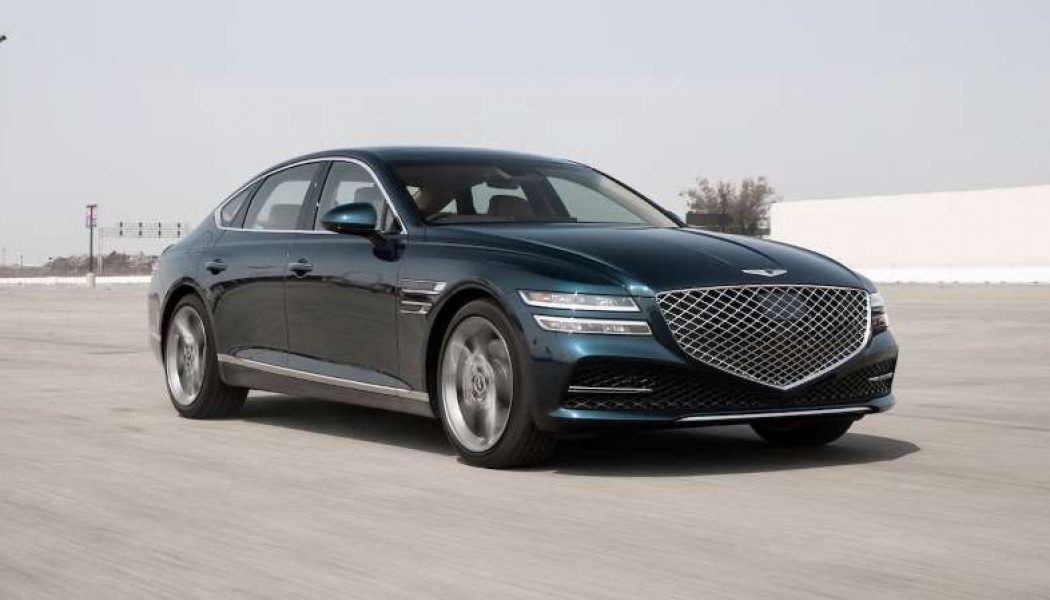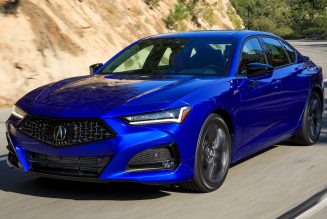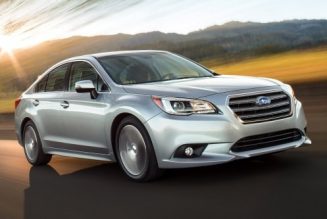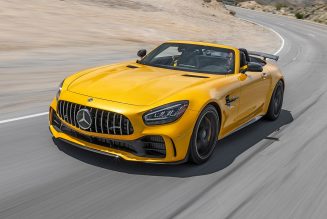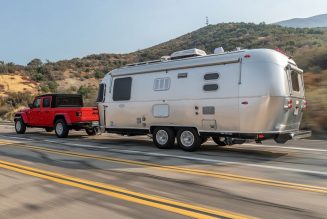“Korean design.” That phrase wouldn’t have conjured much of a mental picture in Americans a few years ago, but between the architecture and home aesthetics on display in the Oscar-winning movie Parasite and the great automotive design work Peter Schreyer has been overseeing at Hyundai Motor Group, awareness is up and Korean design is officially becoming a thing—and an interesting thing at that. Study the design of the 2021 Genesis G80, for example, and you’re unlikely to find many cues lifted from establishment competitors like the Audi A6/A7, BMW 5 Series, or Mercedes-Benz E-Class.
And it’s not just the ginormous face-mask grille and ear-strap headlights. Inside, there’s a world-first 3-D instrument cluster display, a novel rotary-swipe knob infotainment interface, and other controls that blaze new ergonomic trails. We’ve now spent several days in three Genesis G80s to assess how well all this “innovation” holds up in daily use. Let’s start with the performance.
How Fast Is the 2021 Genesis G80?
This is one area where Genesis joined the mainstream by switching from the last-gen model’s V-6/V-6 twin-turbo/V-8 engine lineup to offering a four-cylinder turbo and a V-6 twin-turbo in the new G80. Genesis provides a bonus half liter of displacement compared to the competition in each, but this mostly compensates for added weight. Despite new aluminum body panels helping shave 200 pounds of its predecessor, our G80 test cars still weighed 132-438 pounds more than competitors with matching powertrain configurations.
Our 300-hp, 311-lb-ft 2.5-liter AWD G80 zipped to 60 mph in 5.9 seconds and through the quarter mile in 14.3 at 97.2 mph—just ahead of the next closest 248-hp, 273-lb-ft Audi A6 2.0T Quattro (6.0, 14.6 at 93.2) and well ahead of a rear-drive 248-hp, 258-lb-ft BMW 530i (6.2, 14.7 at 95.1). It also handily bests the slightly smaller Acura TLX SH-AWD and Cadillac CT5 AWD, both of which need 7-plus seconds to hit 60 mph.
The tables turn with six-cylinder models, where our rear- and all-wheel-driven 375-hp, 391-lb-ft 3.5T test cars hit 60 mph in 5.0 and 5.2 seconds and the quarter mile in 13.5 at 105.5 mph and 13.7 at 103.8 mph. That’s a good half second off the pace set by the less powerful and torquey 3.0-liter turbos in the German rivals.
Okay, But How Quick Do the G80s Feel?
Turns out the more competitive 2.5T struck most editors as “heavy and underpowered,” though the engine was praised for feeling “less surgey” than it does in the Hyundai Sonata or Kia K5. It also drew criticism for its coarse, grainy sound and for shaking the car a bit on auto-stop restarts—all of which was deemed unbefitting a luxury product (and potentially attributable to its extra displacement). And although features editor Christian Seabaugh found the V-6 to be “closer to the mark than the four-pot,” he countered that “it just isn’t nearly as smooth as the BMW or Mercedes [inline] six-cylinders.” But presuming you don’t plan to race Bimmers and Benzes for pink slips, the 3.5T feels completely adequate for the class and amply lively in most driving situations. Sport mode amps up the throttle and transmission response appropriately while reducing traction/stability control aggressiveness enough to allow some wheelspin at launch.
How Does the G80 Brake and Handle?
Somewhat surprisingly, the 2.5T on its 19-inch Michelin Primacy Tour A/S tires out-brakes both its competitors and the 3.5T test cars (on fatter 20-inch Pirelli P Zero All Seasons). Stops from 60 mph required 116 feet versus 124 feet for both 3.5T models. Our long-term BMW 530i on summer tires was the only four-cylinder rival to stop shorter (103 feet). Conversely, the six-cylinder competitors we’ve tested all out-braked the G80, save for the 2021 Mercedes E 450 4Matic (127 feet).
The story is the same in the handling tests, where the G80 2.5T’s 0.87 g max lateral grip and 26.2-second, 0.68g average figure-eight performance eclipsed all the four-cylinder competition, save for that summer-tired BMW (0.92 g, 25.9 at 0.69 g), while the 3.5T’s 0.84g max lat and 25.9-second 0.71g average performance was topped by all but the Mercedes E 450 4Matic (0.83 g, 26.2 seconds at 0.69 g).
As usual, numbers tell an incomplete story, especially as it concerns the E 450 versus G80 3.5T. “Chassis and steering lack the composure of the E-Class,” Seabaugh said. “The E 450 is as adept at cruising a boulevard as it is negotiating the figure eight. The G80 felt out of place on the latter, displaying lots of body roll, understeer, and frequently-cinching seat belts.” Testing director Kim Reynolds appreciated the lighter-nosed 2.5T’s turn in under braking, but not the terminal understeer that always followed. And he described the 3.5T’s braking as “sloppy” and turn in as “reluctant.” But absent a back-to-back comparison, most drivers will find the G80 3.5T in Sport mode to be a willing dance partner on a favorite twisty road, never requiring midcorner correction of braking and steering inputs.
What About Ride Quality?
Here’s where the Genesis engineers most need to resharpen their pencils. Editors generally agreed that the four-cylinder model rode better on its 19-inch wheels and reckoned the base car would probably feel smoother yet on its standard 245/50R18 rubber. Seabaugh felt the G80s were “finding bumps that didn’t exist” while “always subtly floating and never feeling settled.” Senior features editor Jonny Lieberman said, “It feels as if it’s up on its tiptoes.” Comparisons with an E 450 4Matic on hand concurrently were unflattering, and they caused Lieberman to wonder aloud: “Why does Genesis have all those German engineers on staff? I think if you’re going to enter the E-Class/5 Series segment, you have to match their levels of chassis sophistication. This vehicle simply doesn’t.”
Here’s my assessment: The suspension is not properly tuned to match the natural frequency of the unsprung corners—especially with the larger optional wheels and the adaptive dampers set to Comfort mode. Insufficient damping results in bump-aftershock reverberations and an unsettled demeanor. This all (counterintuitively) disappears in Sport mode without adding significant harshness. This Genesis is the only modern car I’ve driven in Michigan where engaging a sport suspension mode improved the ride. The structural foundation is sound; the tuning just needs a bit more work.
How About Those 3-D Gauges?
Ordering the Prestige package on top 3.5T models of the 2021 Genesis G80 (or GV80 SUV) buys the first application of supplier Continental’s autostereoscopic 12.3-inch 3-D gauge cluster, which uses a “parallax barrier” of super-narrow opaque slits that ensure a viewer’s left and right eyes always see different rows of pixels. Then it’s a simple matter of showing the left and right eyes slightly different images that combine to suggest depth the way a View Master stereoscope toy does. An infrared eye-monitoring camera enables this to work and also supports a driver attention monitoring system.
This flat LCD display succeeds in making gauge numerals appear about 0.5 inch below the needles and the rest of the display. Move your head quickly, and you can briefly see the double images. Gaze at it long enough with your head still, and you notice that the 3-D resolution seems considerably lower than that of the other flat displays. Yes, analog gauges like the speedometer on our 2.5-liter Genesis show similar depth in crystal clarity, but they don’t allow for unique font and needle designs in each driving mode and for a lane watch image to be superimposed when the turn signal is on.
Several editors were irritated that the tachometer needle swings counterclockwise in all G80s in every drive mode. The main screen also lacks the interesting power, efficiency, or coaching displays that BMW and Mercedes offer, frequently defaulting instead to a screensaver depicting current weather. Genesis did borrow a cool display concept from Tesla—an image of the G80 in its lane, showing all vehicles ahead and to its sides—and moved it to the large, color head-up display.
Other Upside-Down/Backward Controls
Not all uniquely Korean design innovations are successful. Very few editors loved the new rotary/toggle/swipe infotainment interface. First, it’s positioned out of reach of a hand resting on the center armrest. It’s also flush with the console surface, so you can’t grip it. What’s maddening is that the properly shaped rotary shifter is positioned where your hand rests. Drivers can safely look for a shifter when stopped; they need to be able to operate the controller with their eyes on the road, so it should be easier to reach and operate. “The infotainment scroll wheel is a hassle,” editor-in-chief Mark Rechtin said, “and I owned a first-gen iPod.” This requires a midcycle fix stat, along with a redesign of the mostly linear screen menus to include some curvature to suggest which way rotating the wheel will move the cursor. As is, I always turned it the wrong way. You can also just touch the screen to control things, but this requires a long-armed reach. Another backward control: You press the steering wheel toggle down to advance to the next track or station instead of up, as in most cars.
Is the 2021 Genesis G80 a Convincing Luxury Car?
Splurge on the Prestige package, and the G80 cossets, coddles, and pampers its occupants as well as or better than most competitors, offering such sybaritic pleasures as a 1,050-watt, 14-channel, 21-speaker Lexicon audio system featuring a five-speaker “sound bar” in front and subwoofers under the front seats; Smart Posture, Ergo Motion, 16-way-adjustable seats; and soft-close doors with acoustic glass in front and window shades in back. In addition to the driver assist systems everyone offers, Genesis provides a Remote Smart Parking Assistant that lets you parallel or perpendicular park from outside the car, plus collision avoidance warnings and braking that cover blind spots, intersection cross traffic, pedestrians, and bicyclists. The front and rear seats are roomier than the competitors’, though the 13.1-cubic-foot trunk is about 5 cubes smaller than in a 5 Series.
What Does the G80 Cost, And Is It a Good Value?
The G80 starts at $48,725, with AWD adding another $3,150. That undercuts the four-cylinder competition by $4,070-$6,525 at similar equipment levels, which can help justify the $4,600 Advance package (three-zone climate, cooled seats, Lexicon audio, matte wood trim, 19-inch wheels, and more) or the $8,900 Prestige pack (the above plus fancy gauges, seats, doors, and even more). At $60,125, the 3.5T only undercuts the BMW 530i by $320, and adding AWD makes it $225-$2,430 more than the Germans, but with considerably more standard equipment and power.
The Genesis brand might not yet command the cachet to earn the valet parking preeminence, but Consumer Reports ranked it second for reliability this year (behind Porsche), and it’s racking up segment wins in J.D. Power initial quality and dependability studies. Although we might prefer many aspects of the Mercedes-Benz E-Class, the spacious, sumptuous, and uniquely Korean G80 remains a highly recommendable midsize luxury sedan.
| 2021 Genesis G80 AWD (2.5T) | 2021 Genesis G80 3.5T | 2021 Genesis G80 AWD 3.5T | |
| BASE PRICE | $51,875 | $60,125 | $63,275 |
| PRICE AS TESTED | $60,575 | $66,525 | $69,075 |
| VEHICLE LAYOUT | Front-engine, AWD, 5-pass, 4-door sedan | Front-engine, RWD, 5-pass, 4-door sedan | Front-engine, AWD, 5-pass, 4-door sedan |
| ENGINE | 2.5L/300-hp/311-lb-ft turbo DOHC 16-valve I-4 | 3.5L/375-hp/391-lb-ft twin-turbo DOHC 24-valve V-6 | |
| TRANSMISSION | 8-speed automatic | ||
| CURB WEIGHT (F/R DIST) | 4,230 lb (52/48%) | 4,296 lb (52/48%) | 4,462 lb (53/47%) |
| WHEELBASE | 118.5 in | ||
| LENGTH x WIDTH x HEIGHT | 196.7 x 75.0 x 57.7 in | ||
| 0-60 MPH | 5.9 sec | 5.0 sec | 5.2 sec |
| QUARTER MILE | 14.3 sec @ 97.2 mph | 13.5 sec @ 105.5 mph | 13.7 sec @ 103.8 mph |
| BRAKING, 60-0 MPH | 116 ft | 124 ft | 124 ft |
| LATERAL ACCELERATION | 0.87 g (avg) | 0.84 g (avg)* | |
| MT FIGURE EIGHT | 26.2 sec @ 0.68 g (avg) | 25.9 sec @ 0.71 g (avg)* | |
| EPA CITY/HWY/COMB FUEL ECON | 20/30/25 mpg | 19/27/22 mpg | 18/26/21 mpg |
| ENERGY CONS, CITY/HWY | 169/112 kWh/100 miles | 177/125 kWh/100 miles | 187/130 kWh/100 miles |
| CO2 EMISSIONS, COMB | 0.82 lb/mile | 0.88 lb/mile | 0.93 lb/mile |
| *Our rear-drive G80 3.5T was tested in Michigan on the same tires as our California AWD 3.5T test car and achieved the same braking performance, so with no Michigan figure-eight venue available, we are estimating equivalent AWD performance figures. | |||
